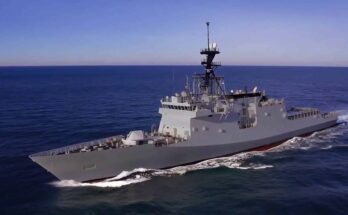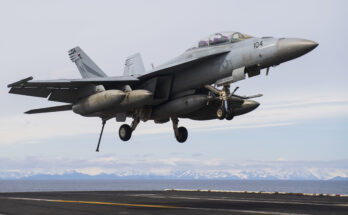
As naval competition picks up in the Indo-Pacific, Australia has launched several initiatives to modernize and expand the Royal Australian Navy (RAN)’s maritime capacities. Complementing the oft-covered trilateral AUKUS deal are several upgrade projects to the country’s surface fleet. The workhorses of the Australian surface fleet, the ANZAC-class frigates, have served with distinction for almost thirty years but are in dire need of replacement. To this end, the Australian government elected to pursue two classes of replacement ships, six ‘Tier 1’ in-development HUNTER-class heavy frigates and 11 planned ‘Tier 2’ General Purpose Frigates, referred to as Project SEA 3000. The competition to supply the General Purpose Frigate has heated up this year, with a government-sponsored Independent Analysis of the Navy’s Surface Combatant Fleet report in February shortlisting five designs for selection.
Among the contenders, a unique design stands out: Japan’s Mitsubishi Heavy Industries’ (MHI) MOGAMI-class 30FFM stealth frigate. Already in service with the Japanese Maritime Self Defense Force (JMSDF), the MOGAMI is a fascinating and advanced ship that, if selected, could have massive implications for both Australia and Japan, as well as the region at large.
Mitsubishi faces stiff competition from four other bidders eager to capitalize on Australia’s defense spending spree. Germany’s ThyssenKrupp Marine Systems’ (TKMS) MEKO A210, Spain’s Navantia Alfa 3000 and South Korean firms Hanwha Ocean and Hyundai Heavy Industries (HHI)’s competing CHUNGNAM FFX-III and DAEGU FFX-II designs are all worthy competitors to the MOGAMI.
The selection process will assess a variety of competing maritime capabilities, as well as the value of each vendor as a door opener to important geostrategic relationships. Additionally, as the RAN hopes to make a swift and affordable replacement of the ANZAC class to avoid a frigate capability gap, experience producing ships abroad in both a technical and legal sense is a key criterion for Canberra’s selection.
Advanced Capabilities Shine
At face value, the MOGAMI is an excellent choice for the General Purpose Frigate competition. The ship is equipped with 16 Vertical Launch System (VLS) cells, a BAE Systems Mk-45 Mod 4 main gun, two remote weapons stations and a U.S.-made SeaRam launcher capable of firing RIM-116 missiles. Although the armament may ultimately be adjusted to offer more compatible systems for Australia, it currently meets the RAN’s needs with weapons provided by close Australian allies. A combined diesel and gas (CODAG) propulsion system powers the ship to a top speed upwards of 30 knots (56 kph) which rates at worst comparable, or at best superior to the other frigate designs under consideration.
The design checks off several of Australia’s further qualifications laid out in the Independent Analysis, including the operation of a towed array sonar, lightweight torpedo capability and handling of a combat helicopter. The MOGAMI’s capacity to serve as a mothership for unmanned systems also works in its favor, fitting with Canberra’s larger push to develop unmanned air and sea platforms.
Where the MOGAMI offers a significant advantage is the variety of advanced features, including a 360-degree Combat Information Center (CIC) which provides a high level of streamlined automation to enhance operational efficiency while dazzling would-be buyers. The key byproduct of onboard automation is a significantly reduced crew complement. The MOGAMI class requires only 90 crewmen to operate, compared to the CHUNGNAM’s 120, DAEGU’s 140, Alfa 3000’s 100 and MEKO A210’s 120. The MOGAMI’s sizable crewing edge is a major accolade, as the Australian Navy faces a crisis of recruitment shortfallings. With lofty ambitions of expanding the fleet, a manpower differential enabled by automated systems makes the MOGAMI a highly attractive option.
With schedule concerns factoring heavily into the RAN’s calculus, Japan’s shipbuilding effectiveness is another advantage. The MOGAMI class has come into service at a rate of at least two a year, proving that the schedule is feasible for MHI and partners, even in high volumes.
Hurdles and Challenges
MOGAMI’s greatest drawback stems not from its capabilities, which are robust, but the comparative lack of experience in building ships overseas. Despite possessing major commercial and military shipbuilding industries, Japan has virtually no experience in exporting warships or constructing them abroad. This unfamiliar territory for Tokyo may make decision-makers in Canberra skittish, particularly with the thin margins of the ANZAC’s replacement timeline. The potential of delays caused by legal oversights, or challenges imposed by a learning curve may be enough to deter the MOGAMI’s selection.
Conversely, Navantia and TKMS are international firms with high levels of shipbuilding experience abroad, including TKMS’ building of the original ANZAC class, and Navantia’s selection to design the Australian Navy’s HOBART class. Even the less global South Korean firms Hanwha and Hyundai have made inroads in securing military shipbuilding contracts elsewhere.
Cost may also have adverse effects on MHI’s bid. While pricing is never obvious, drawing from earlier contracts, the MOGAMI could have a per unit cost of around $400 million. This is likely to beat the Alfa 3000, whose similar AL JUBAIL cousin sold to Saudi Arabia for approximately $435 million each and the TKMS A210, which in Egyptian service cost over $500 million. The South Korean options are the strongest regarding pricing, with the DAEGU costing around $280 million and the CHUNGNAM around $300 million. The MOGAMI could be billed as a middle-cost compromise between the South Korean and European offerings, however, if price is a key determinant for Canberra, a cheaper frigate may be preferable. Given the RAN’s stated concerns about a costly redesign of foreign systems, MHI will also have to assure Canberra that the slate of Japanese systems onboard can be replaced on an Australian MOGAMI without incurring significant extra costs.
A Geostrategic Edge
Beyond the immediate capabilities and drawbacks of the ship, the MOGAMI is a valuable geostrategic tool between Tokyo and Canberra at a critical moment when both nations are seeking closer ties. A MOGAMI selection would advance joint defense ties and enable valuable technology sharing between the two.
Japan has a strong interest in winning the contract, viewing it as a chance to expand its naval export footprint while establishing deeper ties with Canberra amid concerns about China and North Korea’s growing military abilities. Tokyo affirmed in its 2022 National Security Strategy that Australia was the second most important partner for the country behind the United States. While closer ties with South Korea would also be valuable, Spain and Germany have little to offer Australia in terms of regional strategic value.
Building an interoperable force through a shared surface platform would deepen ties between Japan and Australia and set the course for what could be one of the most valuable defense partnerships in the Indo-Pacific theater. Particularly as the AUKUS agreement begins to take shape, informing a great degree of shared capability building and technology sharing, Japan will seek closer cooperation with Canberra. Similarly, offering Japanese firms the chance to develop expertise in shipbuilding overseas would prove valuable in the long term to the AUKUS alliance’s security interests. The role a MOGAMI selection could play in building towards an AUKUS+1 arrangement may be a motivator for Japan and Australia.
* * *
Though legal hurdles and questions of in-country shipbuilding acumen may deter selection, the MOGAMI not only fulfills Australia’s Tier 2 requirements but does so with flying colors, a notably lower crew requirement and valuable regional strategic implications. At a time when rival states have begun to stretch their legs across the Indo-Pacific, the choice of the MOGAMI would be a resounding response from Australia and Japan. The decision will ultimately hinge on the MOGAMI’s ability to balance the immediate needs of the RAN with the long-term strategic benefits of closer ties to Japan. If chosen, the MOGAMI-class frigate could signify a pivotal step towards stronger regional defense cooperation and a more formidable presence in the Indo-Pacific.
Tom Freebairn is a weapons analyst with Military Periscope covering naval affairs and maritime systems. He pursued an undergraduate degree in International Relations and Modern History, followed by a master's in Middle East, Caucasus, and Central Asia Security Studies from the University of St. Andrews. His master's thesis focused on the relationship between oil and separatist politics in Northern Iraq. Tom's interests include the politics of energy, ethnic separatism, the evolution of naval warfare, and classical history.




